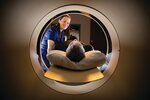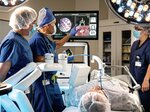According to the American Cancer Society, more people die of lung cancer per year than those from breast, colon and prostate cancers combined. Concerning diagnoses, final estimates for new lung …
This item is available in full to subscribers.
To continue reading, you will need to either log in to your subscriber account, or purchase a new subscription.
If you are a digital subscriber with an active, online-only subscription then you already have an account here. Just reset your password if you've not yet logged in to your account on this new site.
Otherwise, click here to view your options for subscribing.
Please log in to continue |


According to the American Cancer Society, more people die of lung cancer per year than those from breast, colon and prostate cancers combined.
Concerning diagnoses, final estimates for new lung cancer cases in the U.S. hover around 234,000 by the end of 2023, but note: there is good news with these numbers.
Over the past five years, annual case counts have decreased. This means individuals are staying away from things that negatively affect their lung care and are pursuing ways to stay healthy — and breathe a little easier.
At Samaritan, our team of board-certified pulmonologists offers comprehensive pulmonary care to provide the best prevention, detection, treatment and rehabilitation services for patients throughout our area of New York State.
“We’re very proud of lung care services consistently ranked as the best in the region,” says Dr. Aaliya Burza, specializing in Pulmonology and Critical Care.
“Our wide range of care can meet a variety of different needs and, in many cases, address breathing issues before it’s too late.”
Whether you or a loved one is struggling with symptoms of lung cancer or seeking relief from other pulmonary-associated conditions like asthma, sleep apnea and more,
Samaritan is proud to offer advanced procedures and programs that help detect and treat all issues of concern, led by credentialed pulmonologists who can care for you close to home.
Here are some ways we do it:
Screen early
Early detection is a proven, successful strategy for fighting many forms of cancer.
That’s why Samaritan Medical Center’s developed its Early Lung Cancer Screening Program, which offers a low-dose computed tomography (CT) screening for people at high risk for lung cancer.
Because lung cancer has no symptoms in its early stages, more than 85 percent of men and women diagnosed with lung cancer today are diagnosed in a late stage, after symptoms occur and when there is very little chance of cure.
But with Samaritan’s early screening steps, everyone has a chance.“We encourage all patients concerned about their lung health to get screened,” says Maria Pascolini, Samaritan’s director of Radiology. “A CT scan can find 85 percent of lung cancers in their earliest, most curable stage, allowing for treatment and the possibility of eventual recovery.”
Individuals who may benefit from the Early Lung Cancer Screening Program are current or former smokers between the ages of 55-74 and a 30-pack-a-year smoker; or over the age of 50, a 20-pack-a-year smoker, and have one other risk factor for lung cancer.
Cutting-edge bronchoscopy treatments
A bronchoscopy is a procedure that allows doctors to look inside your lungs’ airways (called the bronchi and bronchioles) and find the cause of a lung problem, including such things as bleeding, blockage, infection or existence of a tumor.
At Samaritan, we use different types of state-of-the-art bronchoscopy treatments, depending on the need of the patient.
A technologically advanced robotic bronchoscopy can be used to view the inside of lungs, obtain tissue samples for biopsy and, through use of Auris Health’s Monarch™ Platform, can enable an earlier and more-accurate diagnosis of small and hard-to-reach nodules in the periphery of the lung.Samaritan is the first hospital in Central New York and the North Country to invest in this new technology, and one of only two sites in the entire state to utilize the platform.
This provides the region’s patients with next-generation care for the health concerns of today.
“It’s essential that we invest in these tools to provide the best outcomes for our patients,” says Eva Edwards, Samaritan’s director of Oncology. “They’re allowing us to intervene earlier than we’ve ever been able to, and in turn, save more lives.”
In additional to its robotic bronchoscopy, Samaritan can also perform an electromagnetic navigation bronchoscopy (or ENB), which combines specialized endoscopic tools and technology with traditional bronchoscopy to provide computer-driven guidance, based on a patient’s CT scan.
The tools extend much further into the lungs than standard bronchoscopes, which enables a safe way for physicians to reach more lung tissue for a more accurate diagnosis.
Endobronchial ultrasound
For those who have lung concerns that do not require bronchoscopy treatments, Samaritan offers other, less invasive options to help diagnose issues.
An endobronchial ultrasound (EBUS) uses real-time ultrasound to identify and sample small abnormalities within your lungs without having to perform surgery.
The EBUS system also makes biopsies safer and more accurate than conventional methods, all while providing necessary peace of mind for Samaritan patients.
“It’s all about pursuing the most suitable way to find a solution,” says Edwards. “Patients come here for us to care for them, and whether through or lung care services or Samaritan as a whole, we’re committed to providing this care and helping each patient to enjoy a healthy life.”
Learn more
To learn more about Samaritan and its Lung Care capabilities, visit https://samaritanhealth.com/service/lung-care/.